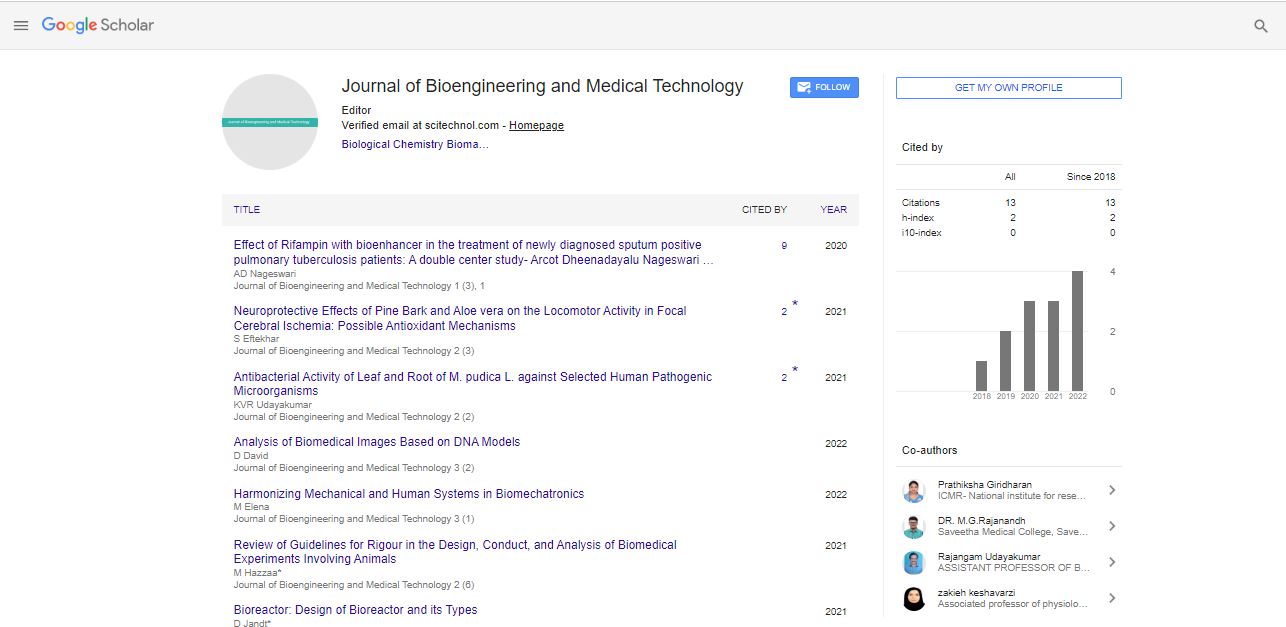Perspective, J Bioeng Med Technol Vol: 4 Issue: 3
Biodynamic Imaging: Unveiling the Concealed Dynamics of Life
Claudia Silveira*
1Department of Biotechnology, Federal University of Rio Grande do Sul, Porto Alegre, Brazil
*Corresponding Author: Claudia Silveira,
Department of Biotechnology, Federal
University of Rio Grande do Sul, Porto Alegre, Brazil
E-mail: silveiraclaudia@gmail.com
Received date: 28 August, 2023, Manuscript No. JBMT-23-118427;
Editor assigned date: 30 August, 2023, PreQC No. JBMT-23-118427 (PQ);
Reviewed date: 13 September, 2023, QC No. JBMT-23-118427;
Revised date: 20 September, 2023, Manuscript No. JBMT-23-118427 (R);
Published date: 27 September, 2023, DOI: 10.4172/JBMT.1000078
Citation: Silveira C (2023) Biodynamic Imaging: Unveiling the Concealed Dynamics of Life. J Bioeng Med Technol 4:3.
Description
Biodynamic imaging is an emerging field that combines the principles of biology, optics, and advanced imaging technologies to visualize and understand the dynamic processes within living organisms. Biodynamic imaging represents a cutting-edge approach to the study of biological systems by enabling the real-time visualization of dynamic processes in living organisms. This revolutionary field has the potential to uncover hidden mechanisms within cells, tissues, and entire organisms. Biodynamic imaging integrates principles from biology, optics, and computational methods to capture temporal and spatial information, providing valuable insights into the living world.
Principles of biodynamic imaging
Optical imaging: Biodynamic imaging relies on various optical techniques, such as fluorescence, phase-contrast, and confocal microscopy, to capture dynamic biological processes. These imaging modalities can be adapted to observe specific cellular and subcellular components, allowing researchers to visualize intricate details within living systems.
Time-Lapse imaging: One of the key features of biodynamic imaging is its ability to capture time-lapse sequences. This enables the observation of dynamic processes, such as cellular migration, division, and response to stimuli, in real time. Time-lapse imaging provides crucial information about the kinetics of biological events.
Computational analysis: Biodynamic imaging often involves extensive computational analysis to process and interpret the data. Advanced algorithms and machine learning techniques are employed to track and quantify dynamic changes in the acquired images. This analytical component is essential for understanding the underlying biological mechanisms.
Applications of biodynamic imaging
Cellular dynamics: Biodynamic imaging has been instrumental in studying cellular dynamics. It has provided insights into processes like cell motility, division, and differentiation, which are crucial for understanding development, tissue repair, and disease progression.
Neuronal activity: In the field of neuroscience, biodynamic imaging has become indispensable for visualizing neuronal activity. Techniques like calcium imaging can track the real-time firing of individual neurons, shedding light on complex brain functions and neurological disorders.
Immunology: Biodynamic imaging is valuable in immunology research. It allows scientists to observe immune cells in action, tracking their movements and interactions with pathogens, ultimately contributing to the development of new therapies and vaccines.
Cancer research: Understanding the dynamic behavior of cancer cells is essential for developing effective treatments. Biodynamic imaging helps researchers observe cancer cell migration, invasion, and metastasis, aiding in the development of targeted therapies.
Developmental biology: Biodynamic imaging has revolutionized developmental biology by enabling the study of embryonic development, organogenesis, and tissue regeneration. It provides crucial insights into the formation of complex multicellular structures.
Emerging techniques in biodynamic imaging
Light sheet microscopy: Light sheet microscopy, also known as Selective Plane Illumination Microscopy (SPIM), is an emerging technique that reduces phototoxicity and allows for long-term imaging of live samples. It is particularly useful for observing the development of transparent organisms.
Single-molecule imaging: Single-molecule imaging techniques offer unparalleled resolution in studying molecular interactions within living cells. This method allows the observation of individual molecules in real time, providing insights into biochemical processes.
Super-resolution microscopy: Super-resolution microscopy techniques, such as Structured Illumination Microscopy (SIM) and Stochastic Optical Reconstruction Microscopy (STORM), break the diffraction limit, enabling the visualization of nanoscale structures within cells.
Future prospects
The field of biodynamic imaging is rapidly advancing, with the development of new techniques and technologies that promise to uncover even more about the inner workings of life. Integration with other cutting-edge approaches like optogenetics and artificial intelligence will likely enhance the capabilities of biodynamic imaging in the future.
Biodynamic imaging has transformed our understanding of biological systems by revealing the hidden dynamics of life. This innovative field continues to expand, offering new insights into cellular and subcellular processes, which has profound implications for various scientific disciplines, including biology, medicine, and neuroscience. As technology and techniques continue to evolve, biodynamic imaging will remain at the forefront of biological research, shaping the future of our understanding of life itself.
 Spanish
Spanish  Chinese
Chinese  Russian
Russian  German
German  French
French  Japanese
Japanese  Portuguese
Portuguese  Hindi
Hindi 
